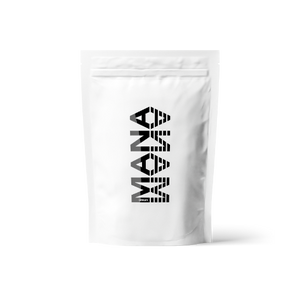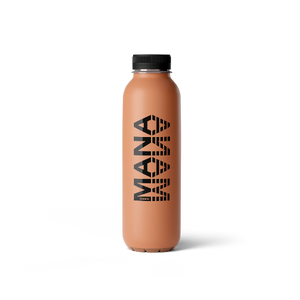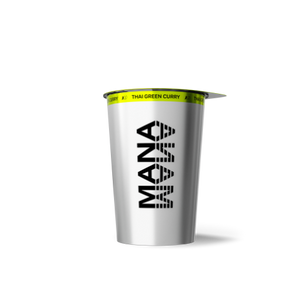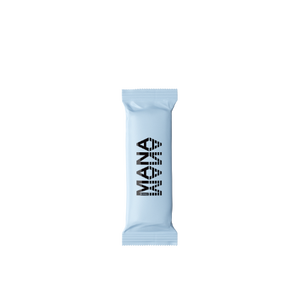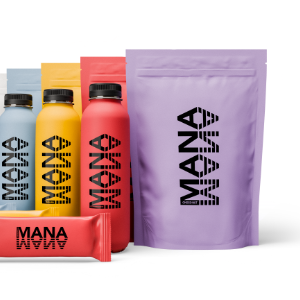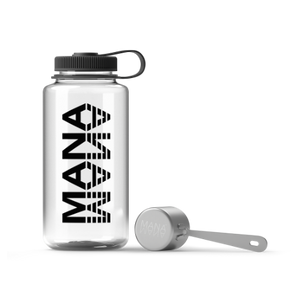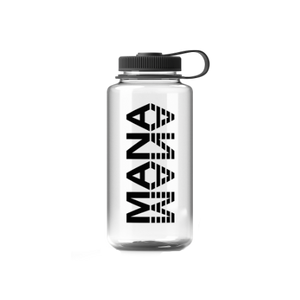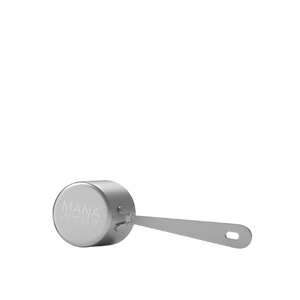Mana and Children: Proper Portioning and Healthy Intake
Average energy intake of children (kcal)
The table below shows the average suitable daily energy intake (kcal) for boys and girls according to the European Food Safety Authority (EFSA), based on age, gender, and physical activity. For reference, one serving of ManaPowder delivers 400 kcal, while one bottle of ManaDrink delivers 330.

* Values correspond to low physical activity (PAL 1.4)
** Values correspond to higher physical activity (PAL 1.8)
Percentage of one bottle of ManaDrink of the average daily energy intake of children
The table below shows the percentage of one bottle of ManaDrink of the average recommended daily energy intake of children and adolescents (see Table 1) by age, gender, and level of physical activity.

* Values correspond to low physical activity (PAL 1.4)
** Values correspond to higher physical activity (PAL 1.8)
How to measure one serving of Mana for children
This table shows the approximate number of scoops of ManaPowder necessary for 1 serving (around 20% of recommended daily energy intake) for children according to age, gender, and level of physical activity (see Table 1 or average daily intake).

* Values correspond to low physical activity (PAL 1.4)
** Values correspond to higher physical activity (PAL 1.8)
Diet is the basis of health. In particular during childhood and adolescence, the requirements for nutrient intake change and the diet should be adapted accordingly. Both excessive and insufficient intake of macronutrients (protein, fat, carbohydrates) or micronutrients (vitamins, minerals) can lead to serious health problems.
Mana is a balanced food that can be safely consumed by children aged 3 and older. Consult a pediatrician or pharmacist before serving Mana to a child under the age of 3.
Optimal nutrition for children and adolescents
Children and adolescents in particular should be encouraged to eat a varied diet and eat regularly (at least 5 times per day). Their diets should be rich in protein, fibre, healthy fat, calcium, and vitamin D, which is important for proper bone development. They should also take in adequate amounts of other vitamins and minerals. Since their bodies are developing, it is essential that their diets are balanced.
Mana should not be a full substitute for a varied diet for this age group, but it may serve as a balanced replacement for fast food, vending machine food, or other sweets. Our Choco flavour is especially appropriate for children and adolescents.
Daily energy intake varies highly among children and adolescents, and can range from 1500 kcal in younger children to 2800 in older adolescents. Table 1 above shows the average suitable daily energy intake (kcal) for boys and girls according to the European Food Safety Authority (EFSA), based on age, gender, and physical activity.
MACRONUTRIENTS
Protein
Protein is an integral part of the diets of children, adolescents, and adults alike. It is a source of nitrogen and amino acids, which are important for the formation of muscles, nerves, and many other tissues. Proteins also act as transporters of other substances. We ensure that Mana has a complete amino acid spectrum in accordance with the recommended intake of the WHO and EFSA.
Essential amino acids include valine, leucine, isoleucine, threonine, methionine, lysine, phenylalanine, histidine, and tryptophan. Some amino acids are essential only during certain periods of psychological development. For example, a fast-growing body needs relatively high amounts of arginine and histidine. The body can partially synthesize these by itself, but not in the concentrations necessary. These 2 amino acids are therefore considered semi-essential.
Detailed information about the protein and amino acid profile in Mana can be found here.
One serving of ManaPowder contains 21 g of protein, while one serving of ManaDrink contains 16 g.
Average protein requirements of children
The following table shows the average daily protein needs of children and adolescents.*

* PRIs – Population Reference Intake (PRI) = intake of a nutrient that is likely to meet the needs of almost all healthy people in the population
** g/kg bw/day - grams per kilogram of bodyweight per day
*** Average protein needs of children and adolescents and average bodyweight of girls and boys
Carbohydrates
Carbohydrates should make up 43-58% of the daily energy intake of children and adolescents, of which sugars should be 16-36%.
Carbohydrates with a high glycemic index (70-100), i.e. those that increase our blood sugar, include monosaccharides, disaccharides, oligosaccharides, and starch. There is also a special group of carbohydrates referred to as "added sugars"; these are mainly simple sugars that are added to foods during manufacture or preparation.
The minimum dose of sugars per day necessary to prevent ketosis (a process characterized by the formation of ketone bodies, whereby the body, from a lack of sugars, initiates lipolysis, i.e. the breakdown of fats) is 50-100 g.
According to the EFSA, a total daily carbohydrate intake of 130 g should be enough to cover the glucose needs of the brain in children over 1 year of age.
The carbohydrates in ManaPowder and ManaDrink are maltodextrin, isomaltulose, oat fibre with beta-glucans, acacia gum, and minor carbohydrates contained in other ingredients. The sugars in Mana are replaced by isomaltulose, which is a source of glucose and fructose. One serving of ManaPowder (86 g) contains 33 g of carbohydrates, while one serving of ManaDrink contains 28 g of carbohydrates, 7 and 6.5 g of which are from sugar, respectively.
Fibre
Fibre is a polysaccharide. Although itself indigestible, fibre plays a very important role in our digestive system. Fibre can be classified as soluble and insoluble (both types are very important).
Soluble fibre in the digestive tract absorbs water and forms a mucus layer, which slows down the absorption of fats and cholesterol (especially LDL cholesterol, which clogs our blood vessels). Due to the fact that it absorbs water and swells in the stomach, it contributes to a feeling of fullness after eating. In addition, soluble fibre acts as an intestinal prebiotic, and is thus food for beneficial intestinal bacteria.
Insoluble fibre cleanses our intestines and speeds up the passage of food through our digestive tract. It also reduces the absorption of sugars, thereby lowering the glycemic index of the foods in which it is contained.
However, consumption of fibre significantly higher than the recommended daily amount does not have a positive effect on our health. Fibre overload reduces the amount of nutrients absorbed, in particular divalent minerals minerals such as calcium, iron, and zinc, which form insoluble compounds with phytates or other substances contained in fibre.
One serving of ManaPowder contains 7 g of fibre and one serving of ManaDrink contains 4.4 g.
Average fibre intake of children
The following table shows the average daily fibre intake of children by age, as well as what percentage of daily fibre intake is covered by 1 serving of ManaDrink and ManaPowder.

Fat
Fats are a very important component of food. Not only are they the main suppliers of energy to the body, but they form cell membranes, which act as carriers of certain vitamins (A, D, E, K) and antioxidants. They are also part of bile acids.
Fats can be divided into saturated and unsaturated fatty acids. Among unsaturated fatty acids are most notably omega-3 and omega-6 fatty acids. These fatty acids are essential, meaning the body cannot produce them on its own, but must get them from food.
Omega-3 fatty acids prevent heart attacks, protect against atherosclerosis, reduce platelet clotting, and are generally healthy. There are 3 main types: EPA, DHA, and ALA long-chain fatty acids (EPA - eicosapentaenoic acid, DHA - docosahexaenoic acid, ALA - alpha-linolenic acid).
The minimum intake of EPA and DHA per day for children aged 3 and over is 250 mg. This intake is the minimum, but not optimal, which is why Mana has an increased amount of omega-3s. One serving of ManaPowder (86 g) contains 1.3 g of omega-3 fatty acids while one ManaDrink contains 1.1 g.
ALA helps maintain normal blood cholesterol levels, and should make up at least 0.5% of daily energy intake. One serving of ManaPowder contains 1280 mg of ALA and one serving of ManaDrink contains 1090 mg.
Among omega-6 fatty acids is linoleic acid (LA). The threshold amount for linoleic acid has not been determined, although according to the WHO, LA should make up 4% of the reference daily intake for children aged 3 and older.
MICRONUTRIENTS
Vitamins and minerals
Vitamins and minerals are an important part of the diets of both children and adults. During adolescence, the body even has an increased need for certain vitamins and minerals. For example, calcium, which plays a role in the formation of bones, is very important during this period. Absorption of calcium is also related to intake of vitamin D.
Recommended daily intake of vitamins and minerals for children
The table below shows the recommended daily intake of vitamins and minerals for children and adolescents. These values can be compared with the amounts of nutrients in one serving of ManaPowder and ManaDrink.

* AI - adequate intake = average nutrient intake based on observations or experiments, which is considered reasonable.
** PRI - population reference intake = intake of nutrients that is likely to meet the needs of almost all healthy people in the population.
F - girls, M - boys, RE - retinol equivalent (1 μg RE = 1 μg retinol = 6 μg β-carotene = 12 μg other carotenoids with the activity of provitamin A)
Sources:
[1] European Safety Food Authority (2019) Dietary Reference Values for Nutrients Summary report.
https://efsa.onlinelibrary.wiley.com/doi/epdf/10.2903/sp.efsa.2017.e15121
[2] Potravinyinfo.cz (2016) Zpráva o potravinách určených pro sportovce.
https://www.potravinyinfo.cz/33/nove-doporucene-vyzivove-davky-efsa-hlavni-nutrienty-uniqueidmRRWSbk196FNf8-jVUh4EstVtRjpnQxZWYxVi7BSQEiw9PBWuC7BmQ/?query=doporu%E8en%E9%20v%FD%BEivov%E9%20d%E1vky%20efsa&serp=1
[3] MUDr. Eva Kudlová, CSc. Význam různých druhů sacharidů v dětské výživě.
https://www.pediatriepropraxi.cz/pdfs/ped/2017/03/06.pdf
[4] European Safety Food Authority. Dietary Reference Values for the EU.
https://www.efsa.europa.eu/en/interactive-pages/drvs
